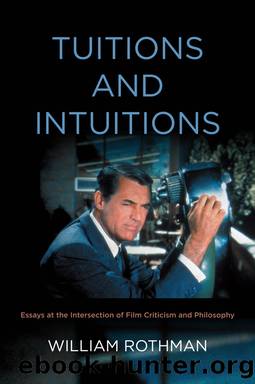Tuitions and Intuitions by William Rothman;

Author:William Rothman;
Language: eng
Format: epub
Publisher: State University of New York Press
Published: 2019-01-15T00:00:00+00:00
11.29
11.30
11.31
11.32
Robin Wood claims that Late Spring is unambiguously a tragedy.4 Surely it is not: Noriko has a fair shot at a happy life. She would be no less grateful to her father if she knew of his lie, for she would also know the truth behind it, that her happiness is the most important thing in the world to him. The unutterably sad truth that Noriko comes to know in this passage, the knowledge, or self-knowledge, that the shot with the vase invokes, is that what she is losingâthe life her father is giving her no choice but to abandonâis precious, and irreplaceable. The truth that we come to know at this momentâwhether for the first time or the thousandth, it makes no differenceâis that, for human creatures like us, there can be no love without loss.
As Iâve said more than once, in an Ozu shot/reverse-shot sequence each character is filmed from the otherâs position, not necessarily from the otherâs point of view. It makes no difference, as far as the cameraâs position is concerned, whether the characters are looking at each other. Andâapart from exceptions that prove the ruleâwhen a shot of a character does correspond to the otherâs literal view, it is still not a conventional point-of-view shot, because the person on view is not the object of the otherâs gaze, but a subject with his or her own gaze. Likewise, the reverse shot that follows is not a point-of-view shot. Nor is it a reaction shot. Although it is taken from a characterâs position, the shot is not expressive of, not limited by, that characterâs subjectivity. Neither is it expressive of, nor limited by, Ozuâs subjectivity. Hitchcockâs camera represents him personally, I want to say, while Ozuâs cameraâif we can even call it thatâis impersonal, impartial. An Ozu shot/reverse-shot sequence effaces or transcends his own selfâis this his Buddhism?âso that we may view all the characters filmed by the camera as expressing themselves to us, and to us aloneâor to themselves. And yet, paradoxically, what occasions Ozuâs use of the technique is precisely the fact that this character is not alone at this moment, is making a connection, or denying a connection (which is a way of making a connection), with a particular person in the worldâa person who is examining his or her mind, or failing to do so, who is responding to his or her passionate appeals, or failing to do so.
Ozuâs characters make moral claims upon each other, particular claims they may or may not have the standing to make. His way of filming their conversationsâshooting each from the otherâs position, as if each in turn is speaking to the cameraâputs us in the best possible position to assess their claims. The most memorable of Ozu shot/reverse-shot sequences exemplify a limiting caseâor an ideal caseâin which a meeting of minds approaches the condition we call âsoul-searching.â The screen as window, and the screen as mirror, converge.
Not all conversations in Ozuâs films have this quality. But when they do not, we know they do not.
Download
This site does not store any files on its server. We only index and link to content provided by other sites. Please contact the content providers to delete copyright contents if any and email us, we'll remove relevant links or contents immediately.
How To Write A Damn Good Thriller by James N. Frey(393)
Naked as Nature Intended by Pamela Green(372)
30 Movies to Get You Through the Holidays by Roger Ebert(364)
Bond, James Bond by Brad Gilmore(306)
It's Only a Movie! by Haberski Jr. Raymond J(296)
Chinese films in focus II by Unknown(260)
The Fellowship of the Knits: Lord of the Rings: The Unofficial Knitting Book by Tanis Gray(249)
How To Write A Novel The Easy Way Using The Pulp Fiction Method To Write Better Novels: Writing Skills by Jim Driver(240)
The Greatest Show on Earth by Jerry Pinto(230)
Smartphone Cinema: Making Great Films with Your Mobile Phone by Bart Weiss(218)
Film Truth; November, 1920 by Anonymous(218)
The Garden in the Machine by Unknown(213)
The Reel Truth by Reed Martin(206)
Charles McGraw by Alan K. Rode(205)
Jurassic Park and Philosophy by Watkins Jessica Michaud Nicolas(204)
Thomas Mann and Friedrich Nietzsche: Eroticism, Death, Music, and Laughter by Caroline Joan Picart(204)
Jafar Panahi: Interviews by Unknown(201)
The Japanese Cinema Book by Hideaki Fujiki & Alastair Phillips(198)
Euro-Visions: Europe in Contemporary Cinema by Mariana Liz(194)
